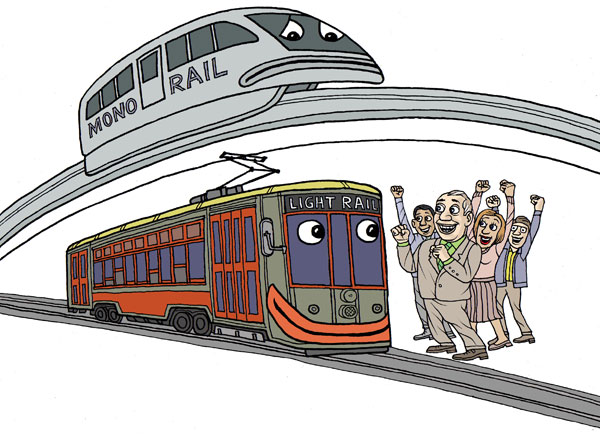Streetcars vs. Monorails
Jan. 12, 2011
By Tom Vanderbilt
Read More: http://www.slate.com/id/2280972/pagenum/all/#p2
------------
There is a great, if unnamed and often overlooked, attraction in Disney World: Transportationland. As any visitor knows, one of the most striking experiences at Disney World is navigating it. The place offers an impressively multi-modal suite of options. There's walking, horseless carriages, steamboats, the famous monorail (said to carry more passengers than most U.S. light-rail systems), horse-drawn trolleys, the Tomorrowland Transit Authority PeopleMover, not to mention mobility scooters and, at some parks, bikes. Then there's the bus fleet that shuttles visitors from the parking lots to the entrance gates. (If it were a municipal fleet, a Disney engineer once told me, it would be the 21st largest in the United States.)
- What's interesting about Disney World and Disneyland is not merely the range of transportation options, but the mixture of new and old modes they represent. These varied ways to get around reflect biographer Neal Gabler's observation that Walt Disney was "at once a nostalgist and a futurist, a conservative and visionary." One imagines he would have been equally happy riding the retro trolley on Main Street as whisking through Tomorrowland in an ultramodern monorail.
- But there is something else to note here. The monorail—which must have looked to Disney and the world like the transportation of the future in the 1950s—is now, to many, considered a historical footnote, a relic of World Expos or, at best, an automated ride between airport terminals. America's highest-profile monorail project, the expansion of Seattle's line, was plagued by cost overruns and funding gaps, and was finally dissolved in 2005 (costing taxpayers $125 million).
- The Las Vegas monorail has filed for bankruptcy. At the same time, those retro streetcars, which Disney himself rode in Kansas City in the early 20th century and which must have seemed to him part of a vanishing past, are returning (or may soon return) to any number of American cities, including Washington, D.C.; Cincinnati' Tucson; Atlanta; Dallas; St. Louis; and Salt Lake City.
- So the future we thought we were going to get somehow seems antiquated, while the past looks increasingly, well, futuristic.
Why is the trolley ascendant as the monorail declines?
- The first thing to know about the monorail—which, simply defined, "guided transit vehicle operating on or suspended from a single rail, beam, or tube"—is that it has a long history of being the transportation of the future. "One of the most enduring ideas in transportation has been the monorail," notes William Middleton in Metropolitan Railways, "which in a variety of forms has been offered as the solution to urban transportation ever since the late nineteenth century." The inventor Joe Vincent Meigs demonstrated his patented monorail scheme in East Cambridge, Mass., in 1886. There were other, more fantastical schemes, like the Boynton Bicycle Electrical Railway, but as Middleton notes, this, too, "like almost all monorail schemes, was soon forgotten."
- Modern monorail partisans insist theirs is a viable, if misunderstood, transportation form. (Thanks a lot, Simpsons.) The Web site of their leading organ, The Monorail Society ("Monorails … They're Not Just for Theme Parks and Zoos!"), extols successful monorails around the world (Tokyo-Haneda, the Shanghai Maglev, a monorail slated for the Philippines!) and argues their benefits: Safe (with some exceptions), popular, and cost-effective. The failure to spread in cities worldwide reflects, they argue, a sense that they are still "experimental." It is as if they can't shake the perception that their moment is not yet here. As Wayne Curtis wrote, "the monorail was twenty years ahead of its time, and it has been mired there ever since." And, more conspiratorially: "Something some transportation experts have whispered to us over the years is that a lot more people can make a lot more money if light rail or subway is built."
- Streetcar supporters counter with a battery of well-practiced rejoinders. They say streetcars are cheaper than monorails. Sure, Japanese monorail systems make money, they argue, but so do Japanese trains. Light-rail—a term that has a somewhat slippery definition, but which I'm using here to refer to streetcars (whether modern or vintage in style) that run short routes with frequent stops at street level—has a proven track record in America and has carried infinitely more passengers. Supporters also claim that streetcars promote urban development—which seems possible if not proven. (Streetcar people, like monorail people, even have their own conspiracy theories about what's holding them back.)
- In a conciliatory note, streetcar fans acknowledge that monorail is suitable "where nothing else fits and there is a need to connect at least two points of high activity"—situations in which you wouldn't have to build lots of expensive elevated stations or worry about a lot of network "branching." And if monorails are haunted by their forward-looking past, a rap on many streetcars is that they are simply vehicles for nostalgia rather than real transportation, "Disneyland toys," as Randall O'Toole snorts. As a famous article, Don Pickrell's "A Desire Named Streetcar," noted, municipal officials have persistently underestimated light-rail construction costs and overestimated eventual ridership numbers. (A later study noted planners had gotten better on rider forecasts but no better on capital costs.) Transit advocates (even those on the political right) retort that all kinds of highways "lose" money; some even go bankrupt.
..........







